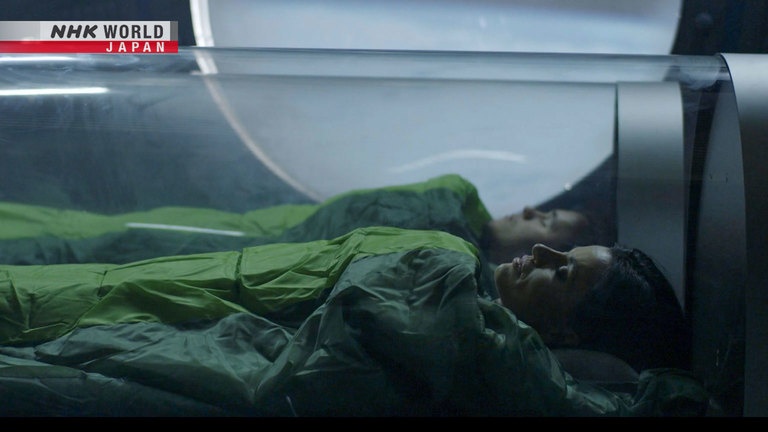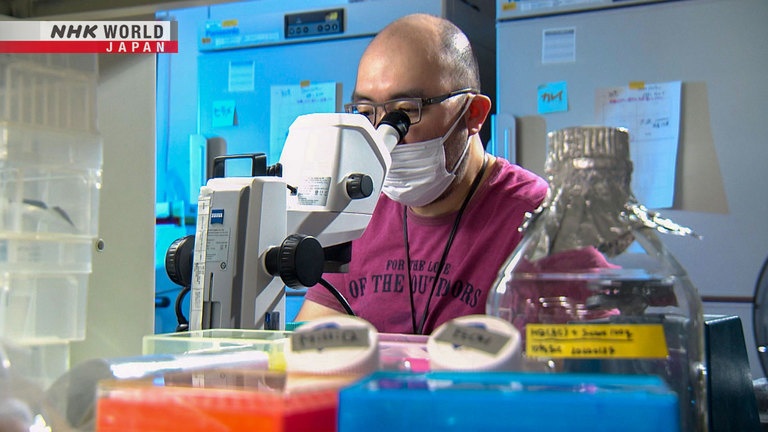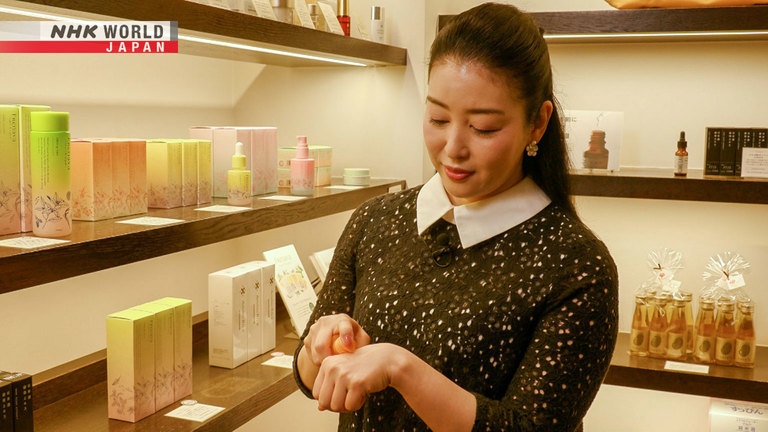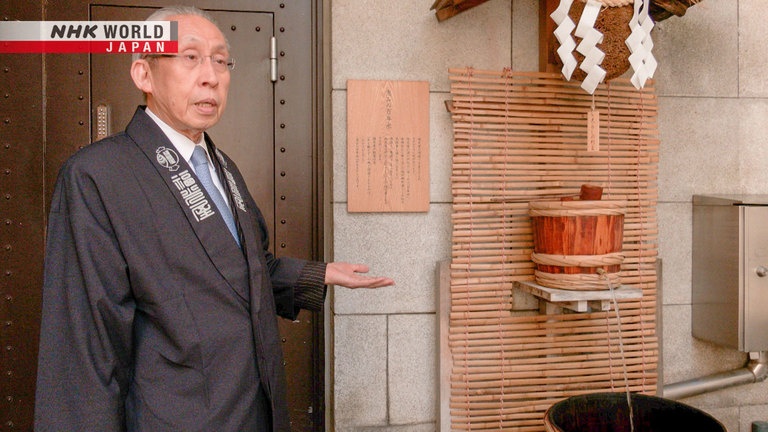Artificial Hibernation: No Longer Sci-fi!
Hibernating animals survive by minimizing energy use. Artificial hibernation could increase the window for emergency medical treatment or even allow us to reach the stars. A RIKEN research institute team has induced a hibernation-like state in mice. Dr. Ko Kobayakawa of Kansai Medical University has found that the scent of a mouse's natural enemy creates a similar state. See the latest in hibernation research. J-Innovators presents an innovative brewer using sake brewing knowhow for cosmetics!
[J-Innovators]
Cosmetics using fermentation techniques from sake brewing.




Transcript
Hibernation.
This survival technique that allows certain animals to make it through winter remains mysterious.
It allows them to survive exposure to cold and the risk of starvation by minimizing the use of energy.
Artificial hibernation: replicating this natural process for the benefit of humans.
Multiple research efforts are now yielding results that could make it a reality.
Artificial hibernation, by reducing the body's metabolic rate,
could increase the window for emergency medical treatment.
And it could someday allow us to reach the stars, a journey otherwise too long.
Humans are on the verge of a third
state that is neither life nor death.
Could you and I really be able to hibernate?!
Today, we're in pursuit of the latest in hibernation research.
This is Science View.
And I'm your host, Tomoko Tina Kimura.
Today, were looking at hibernation.
It may sound like science fiction,
but the era when humans too are capable of hibernation could be just over the horizon.
Joining us is Mr. David Hajime Kornhauser, Director of Kyoto University's Office of Global Communications.
Mr. Kornhauser, it's a pleasure to have you with us.
Thank you. I'm glad to be here.
So, Tina, what do you think of when you hear the word, "hibernation?"
The first thing that comes to mind is the bear.
They hibernate during the winter when there is not enough food.
That's right, it allows animals to survive harsh winters with no food or water.
What's more, muscles don't weaken and there's no damage to internal organs.
Wow, I didn't know that.
Ordinarily, you'd expect some decline in function.
True. By the way, the Siberian chipmunk also hibernates.
But when not in hibernation, its body temperature is normally around 37 degrees Celsius.
That's not too different from humans.
Yes. What do you think it's body temperature is during hibernation?
It must be lower than usual.
About 30 degrees, maybe?
Believe it or not, it goes down to as low as 5 degrees Celsius.
5 degrees? If I were to come across a hibernating animal, I would probably assume it to be dead!
Artificial hibernation is an attempt to allow humans to use this same mechanism.
So, what are the potential benefits?
It's believed that lowering the metabolic rate, as well as reducing oxygen intake,
could increase the narrow window of time needed for treatment during medical emergencies
by minimizing damage to the brain and other organs during transport.
It seems there's been a breakthrough that may well make such artificial hibernation a reality.
Let's start with a look at the research.
In 2020, a paper was published by a team of researchers in Japan.
They were able to induce hibernation in a mouse, an animal that ordinarily doesn't hibernate.
One of the research team members was Dr. Genshiro Sunagawa of the RIKEN research institute.
Originally a pediatrician, he worked with severely ill children at one of Japan's leading pediatric hospitals.
This led to many bitter experiences.
Even with the treatments now available,
some cases are beyond hope.
You do your best, and if you could
do one more thing, they'd recover.
Just make it through one terrible day,
and they'd have a bright, long future ahead.
You feel resignation and frustration.
He reached a turning point after he came across a paper on lemurs that hibernate.
It said that lemurs, primates like humans, could remain alive using minimal energy.
Sunagawa was surprised by the findings.
And he decided to leave medicine to pursue a career in research.
He believed that if humans could be put in this energy-saving state, it could help save people who are dying.
So, Sunagawa focused on mice, animals that don't hibernate
but can slow their own metabolism in a way similar to those that do.
Mice are known to enter a state called "daily torpor",
in which their metabolic rate slows down for several hours in certain conditions, such as a lack of food.
He wondered if it might not be possible to induce such a state in humans to reduce their metabolic rate.
His research focused on target temperature.
That is, the body temperature hibernating animals aim to reach during hibernation,
an important factor in slowing metabolism.
When measured, they found that temperature in hibernating animals dropped by as much as 27.5 degrees Celsius,
while for mice in torpor it was only around 3.8 degrees Celsius.
There appeared to be a significant difference between the two states.
I remember getting the results
and being a little disappointed.
Metabolism only dropped slightly,
unlike in true hibernation.
However, 2 years later, an accidental discovery by another researcher lead to a major leap forward.
Dr. Takeshi Sakurai of Tsukuba University.
When stimulating certain neurons as part of his research on substances in the brain involved in sleeping and waking,
something unusual happened.
I was stimulating a specific nerve cell
and the mouse just stopped moving.
As I was attempting to observe
its various physiological states,
the mouse had entered a state
indistinguishable from hibernation.
As he stimulated neurons to investigate the function of the hypothalamus...
...the mouse became cold and motionless for several days.
He found that the phenomenon was caused by a group of brain cells known as "Q-neurons" located in the hypothalamus.
What was happening in the mouse's body when this occurred?
As a friend of Sunagawa's, he reached out to help him develop a way to measure a mouse's metabolic activity while in such a state.
When I first got the message
I was shocked, really surprised.
At the start of the experiment, the mouse's body temperature is 37 degrees Celsius.
Then the Q-neurons are stimulated.
Its body temperature drops rapidly to 24 degrees Celsius, nearly room temperature.
In addition, the mouse's oxygen consumption...
drops blow half of what it was immediately after the stimulus is applied.
And the mouse remained in this state for several days afterward.
These results clearly show that the condition more closely resembles hibernation than daily torpor.
The discovery of Q-neurons
means there's a real possibility
that non-hibernating animals
could achieve a similar state.
So, it may be possible that, by stimulating these Q-neurons, humans might also be able to hibernate?
Yes. The "Q" in "Q-neurons" actually comes from a peptide called QRFP, essentially a kind of protein.
QRFP is common among mammals, including humans.
Findings show that stimulating nerve cells that contain QRFP,
especially those found in the hypothalamus, leads to a drop in body temperature.
If QRFP is also found in humans, does that mean we can also hibernate?
Well, it hasn't been confirmed that Q-neurons are the actual "switch" to activate hibernation,
but it certainly looks promising.
So more specifically, how could this help in medical emergencies, for example?
Well, if you take some time for an ambulance to come to the scene,
then, let's say during this time say the heart stops, or breathing stops,
the cells and organs gradually become starved of oxygen and nutrients.
If you induce hibernation at this time you could survive on very little oxygen.
This could mean more time to transport and treat such patients.
So this could actually be a revolutionary advance in medical science.
Right. Here's another interesting idea.
The most recent ice age is believed to have happened about 10 to 15,000 years ago.
Humans or, more specifically, our hominid ancestors are actually ice age survivors.
Findings outside Japan suggest that ancient people may have hibernated.
Thousands of hominid bones found in a cave in Spain.
Around 500,000 years old, believed to be ancestors of the Neanderthals.
The bones come from an extinct hominid species called Homo heidelbergensis.
Professor Antonis Bartsiokas, research team leader, eventually came to believe in the possibility of hominid hibernation.
I didn't believe in the first place there was hibernation,
but when I saw there was rickets, then this idea came to my mind.
Here's the top of one of the skulls.
It shows early signs of rickets, a condition in which weakened bones recede.
Since rickets is caused by a lack of sunlight, he believes they may have been hibernating in dark caves for months.
And there's also this finger bone.
It's full of holes.
How could this be?
When under severe stress from cold and lack of sunlight, a stress hormone called cortisol is produced.
This stress hormone causes secretion of parathyroid hormone and leads to a calcium deficiency in the body.
When this occurs, the missing calcium is replaced with calcium from the bones.
This leads to bone depletion.
The condition of many of the bones that were found can only be explained
by extreme stress due to a long period of exposure to severe cold and darkness.
But this alone could be explained by simply having spent the cold season living inside a dark cave.
The deciding factor was this: As you can see, the bone appears to be made up of multiple layers.
These represent alternating periods of bone growth and bone recession.
We have every year, there was a gap in the formation of the bone layers.
And this gap was formed during hibernation, because there was no formation of bone during hibernation.
And this is the diagnostic character for hibernation, so that's why I knew that we had hibernation.
So, this suggests that we may really be able to hibernate.
Suppose that ancient hominids actually carried genes for hibernation.
As climate and environment changed over time, the ice age ended and things got warmer,
anyone born who couldn't hibernate could still survive.
But the ability may still be there in some people.
It's definitely a possibility.
Earlier, we discussed Q-neurons, but ongoing research is looking into a surprising mechanism
that also puts animals into a hibernation-like state.
Dr. Ko Kobayakawa of Kansai Medical University has been researching the sense of smell using mice as subjects.
He's successfully used a certain odor to trigger a hibernation-like state in them.
It's an artificially made smell of fear.
"Thiazoline fear smell."
A scent molecule that resembles the odor of a mouse's natural enemy.
Let's see what happens when a mouse is exposed to the fear smell.
Around seven minutes later...
It's frozen, nearly no movement.
A look at the mouse's body temperature reveals...
after taking in the scent, similar to hibernation, it falls quickly.
It seems its metabolism also drops.
What actually happens inside the mouse?
When the fear smell molecule is detected by sensors in the nasal cavity and throat...
Information is transmitted by the olfactory nerves to the brainstem, and then to the midbrain.
This sharing of information between the brainstem and midbrain determines that there is danger.
This induces a defense reaction, stopping movement and lowering body temperature to evade a predator.
The activation of the midbrain also has another surprising effect in life-threatening situations.
Normally, a mouse can only survive for around 10 minutes in a low-oxygen environment.
Mice exposed to the fear smell survived for an average of 4 hours.
Stopping blood flow to the brain can cause a stroke leading to widespread damage,
but after exposure to the fear smell, the damage is much more limited.
Why does danger bring out the strength to survive?
Dr. Kobayakawa hopes to uncover the mechanism and apply the results to humans.
For example, oxygen masks,
any odor released in one
would be readily smelled, wouldn't it?
Say, if scent stimulus were able to
help patients in an ambulance,
it'd be astounding, revolutionary!
That's the goal of my current research,
and I think it looks very promising.
So, from Q-neurons... to smell.
There's a real variety of approaches that could induce hibernation.
I think it's very meaningful, as it shows there are multiple potential ways to induce a hibernation-like state.
Mr. Kornhauser, what do you think the future of artificial hibernation will look like?
For example, it may start with organ-specific hibernation,
and then achieve a period of several hours or days of full-body hibernation useful in emergency medical care.
After that, there's space travel, and even perhaps time travel, preserving ourselves to wake up in the future.
There're so many possibilities!
Yes. By investigating what happens to animals during hibernation,
we may get a clearer understanding of life itself, and what makes something a living thing,
the smallest necessary "spark" if you will, for something to be alive.
That's right. Understanding the amazing potential of hibernation,
I hope that science will continue to unravel its mysteries and we can apply it to improve our lives.
Moving on, we turn to the fusion of food and beauty.
Specifically, skin care products created through fermentation.
Japanese fermented foods like miso or sake are now familiar worldwide.
Today's Takumi is an innovative brewer with a 390-year history.
We highlight the company's efforts to develop new ideas using the wisdom of the past.
We visited this sake shop in Roppongi, Tokyo which is run by a brewer.
This long-established sake brewer has been in business for 390 years.
However, the star of the show today is not sake...
These are cosmetics made with
sake fermentation technology.
Cosmetics from sake?
Now let's try out the serum.
Let's see.
Wow. This is very rich.
Look at this.
Oh, it's really, really... it sucks in.
Since the 1980s, this sake brewer has been developing cosmetics using its sake-making techniques.
It now accounts for 10 percent of sales.
But why is a sake brewer making cosmetics?
To solve the mystery, we went to Kanazawa City, Ishikawa Prefecture.
Kanazawa City, is a popular tourist spot where Japanese traditional culture still thrives.
The brewery we visited is the oldest in the city.
Hello. Welcome. I am Fukumitsu,
the 13th president of Fukumitsuya.
Today's Takumi or innovator is Fukumitsu Matsutaro.
I would like to show you something.
First, he led us to...
This is groundwater from rain
that fell about 100 years ago.
Hakusan, one of Japan's three most famous mountains, is the source of this underground water.
Rain and snow from Mt. Hakusan over a long period of time gush out as mineral-rich water.
This water is used in all of their products, from sake to cosmetics.
The minerals provide nutrition
for the yeast during fermentation.
It gives the process a real boost.
We think of it as the water of life
for our brewery.
We were shown some sake being brewed.
This mash is fermenting right now.
The starch in the steamed rice is broken down into sugar by malt,
and this sugar is fermented into alcohol by yeast.
The idea of using this sake to make cosmetics came from an old tradition.
It's said geisha in Kanazawa used sake to make their skin beautiful.
However, the problem is the alcohol.
It was necessary to develop alcohol-free cosmetics to reduce irritation to the skin.
The breakthrough was when
I came across a yeast that
fermented well and made amino acids
but didn't produce alcohol.
Of the 300 yeasts stored at the company, there was just one that had a very low capacity to make alcohol.
We called it, "dropout yeast."
The modern trend is sake with
less amino acids and more alcohol.
This yeast goes against the grain.
So, when I say it's a dropout,
I really mean it.
However, when this yeast was examined from the perspective of cosmetics development,
it turned out to be highly potent.
Compared with ordinary sake yeast, its ability to produce amino acids
that moisturize the skin was more than three times greater.
In addition, recent research has revealed that fermented products such as sake are rich in "D-amino acids,"
which have high antioxidant properties, such as extending the life of skin cells.
Among Amino acids, D-amino acid and L-amino acid are mirrored in structure.
Previously, it was believed that only L amino acids existed in nature,
but with improved identification, D-amino acids have been discovered in recent years.
D-amino acids are abundant in babies' skin but drop to less than 1/3 by our 20s.
But why are D-amino acids abundant in fermented products, like sake?
It's produced by fermentation,
but mainly by bacteria.
It is said that lactobacilli and
other bacteria produce them.
It is now known that that's
where D-amino acids are made.
They're also developing pharmaceuticals and functional foods using the technology cultivated in sake production.
Nothing is more wonderful than fermentation.
You can make things with it
that would probably be impossible
to make with science or chemistry.
Japanese food culture is fascinating,
and I think it will continue to spread
throughout the world in the future.